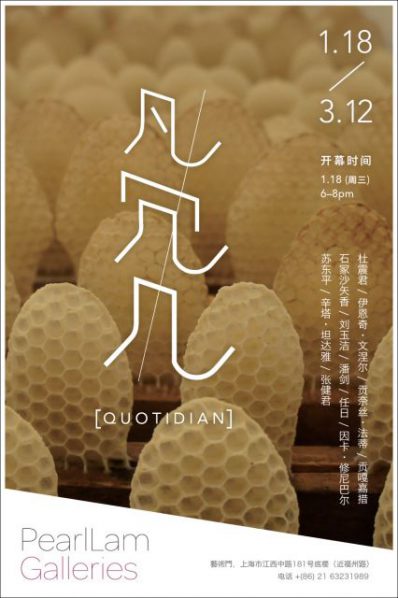
Pearl Lam Galleries is delighted to present Quotidian, a group exhibition that strives to transcend the quotidian, or the ordinary, by questioning existing norms through continual artistic explorations. In turn, this exhibition aims to provoke audiences to re-experience seemingly familiar visuals in a different way. This exhibition features works by twelve contemporary artists: Du Zhenjun, Inci Eviner, Golnaz Fathi, Gonkar Gyatso, Sayaka Ishizuka, Liu Yujie, Pan Jian, Ren Ri, Yinka Shonibare MBE, Su Dong Ping, Sinta Tantra, and Zhang Jian-Jun. Quotidian can be mundane, trivial, and even obscure, but never pointless; it is a necessary condition, as people strive to break free of the everyday to achieve innovation and progress.
Selecting often overlooked objects, such as rice, cutlery, and thread from daily life as both the mediums and subjects of her creations, Japanese artist Sayaka Ishizuka (b. 1980) retells the stories of these “lived” objects and their owners. By collecting used items from her friends and community, Ishizuka connects the lives of people and individual experiences to create works that are, altogether universal.
Also exploring existential themes is Chinese artist Ren Ri (b. 1984) who allies with bees to construct hive sculptures, which are the direct result of his daily interaction with the insects. His latest work, Hyperparallel (2016), is an example of bees building their own circular-shaped beehives that grow against gravity inside man-made box frames.
Nature is a subject matter as old as time; Chinese artist Pan Jian (b. 1975) tirelessly paints forest scenes that best encapsulate his mood. Unlike his previous works that engulf viewers with a sense of psychological dislocation, his latest paintings, with their undimmed colour scheme, provide audiences with a dreamlike vision of his emotions.
Also turning inwards for inspiration, Liu Yujie (b. 1984) focuses on indoor landscapes staged with her imagination. Her meticulous attention to composition, tones, and geometric shapes reflects her enthusiastic penchant for blurring the line between commonplace scenes and abstraction.
British-Balinese artist Sinta Tantra (b. 1979) explores dimensions in her paintings with colour and geometric shapes. She embraces bright colours from her Southeast Asian heritage and “collages” these into a structure where pictorial and physical spaces meet.
Also inspired by multiple cultures is British-Nigerian artist Yinka Shonibare MBE (b. 1962). His sculpture Girl Balancing Knowledge (2015) ties the artist’s childhood memories of Nigeria with his education in the UK by depicting a female dressed in his trademark “African” fabric clothing, which was actually first inspired by Indonesian design and mass-produced by the Dutch for sale in West Africa.
Synthesising modern daily lives with Tibetan culture, Gonkar Gyatso (b. 1961) mixes pop elements with Buddhist iconography to demonstrate the influence of global mass media on the shaping of our identity. In 13,472 Prayers (2015), Gyatso conjures up a balanced world where spirituality (the circle) is perfectly contained within the universe (the outer square). Yet, a closer look would enable audiences to realise that the mandala is actually composed of 13,472 stickers.
As one of the earliest Chinese abstract artists, Zhang Jian-Jun (b. 1955) uses water as a symbol of his understanding of time and existence. From his Pond series (1990s) that celebrates the versatility of form to his current series First Drop of Water (2015–16) that connects the past with the present, Zhang is in a continuous pursuit to visualise Daoist beliefs.
Su Dong Ping (b. 1958) is another artist whose works are deeply rooted in Chinese philosophy. His background in traditional calligraphy is reflected in his abstract paintings. By repetitively painting on the same surface, Su underlines a momentary process that is filled with reconstruction and surprises.
A routine, or rather a meditative journey, is often required before spontaneity can be generated. Iranian calligrapher and artist Golnaz Fathi (b. 1972) first developed her artistic style when she was conducting the warm-up exercise practiced before writing calligraphy. Her free-spirited lines that mirror her impromptu gestures and rhythm are in contrast with Persian calligraphy’s standard for precision.
Meanwhile, Turkish artist Inci Eviner (b. 1956) regards drawing as part of her daily practice as she creates figures that are hybrids of her surroundings and imagination. The often uncanny or animalistic characters shadow the artist’s concerns on social issues.
Chinese artist Du Zhenjun (b. 1961) holds an even more pessimistic view towards the future by envisioning a dystopia full of current problems, such as pollution, over-population, and consumerism, in his digital photography. Highlighting this narrative with the biblical story Tower of Babel, Du depicts not only world problems, but also the spiritual lost among all of us.
About the exhibition
Dates: Jan 18, 2017 - Mar 12, 2017
Opening: Jan 18, 2017, 18:00
Venue: Pearl Lam Galleries
Courtesy of the artists and Pearl Lam Galleries, for further information please visit www.pearllam.com.




























